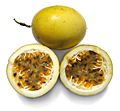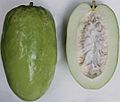Passion fruit (fruit) facts for kids
The passion fruit is a tasty fruit that grows on a type of plant called Passiflora. It's known for its juicy, seedy inside and its bright colors like yellow, red, or purple. People around the world enjoy passion fruit in many ways, from eating it fresh to making delicious juices.
Contents
What's in a Name? The Story of Passion Fruit
The name "passion fruit" comes from the "passion flower," which is what the Passiflora plant is called. Around the year 1700, missionaries in Brazil gave it this name. They used the flower's unique parts to teach about the crucifixion of Christ. For example, they saw parts of the flower as symbols of the "five wounds" of Christ. This helped them explain their beliefs to the local people.
A Brief History of Passion Fruit
Passion fruit first arrived in Europe in 1553.
How Passion Fruit Looks
Passion fruits are usually round or oval-shaped. They can be about 1.5 to 3 inches wide. You can find them in colors like yellow, red, purple, and green. Inside, the fruit has a juicy center filled with many small, edible seeds.
Different Kinds of Passion Fruit
There are four main types of passion fruit that people commonly eat:
- Purple passion fruit: This comes from the Passiflora edulis plant.
- Yellow passion fruit: This is a type of Passiflora edulis called f. flavicarpa.
- Sweet granadilla: This fruit grows on the Passiflora ligularis plant.
- Giant granadilla: This is the fruit of the Passiflora quadrangularis plant.
How to Enjoy Passion Fruit
The most common way to eat passion fruit is to scoop out the pulpy, juicy seeds from the inside. You can eat them fresh, or they can be squeezed to make delicious juice. Passion fruit juice is often used in drinks, desserts, and other recipes.
Passion Fruit and Your Health
Raw passion fruit is mostly water. It also contains carbohydrates, some protein, and a little fat. Eating 100 grams of raw passion fruit gives you about 97 calories.
It's a good source of vitamin C, which helps your body stay healthy. Passion fruit also provides some riboflavin, niacin, iron, and phosphorus. These are all important nutrients that help your body work properly.
Natural Chemicals in Passion Fruit
Some types of passion fruit have natural chemicals called polyphenols. These are found in the peel and juice. Some varieties also contain other natural compounds, mostly in the peel.
Gallery
-
Purple passionfruit (Passiflora edulis)
-
Yellow passionfruit (Passiflora edulis f. flavicarpa)
-
Passiflora ligularis in flower
-
Giant granadilla (Passiflora quadrangularis L.)










